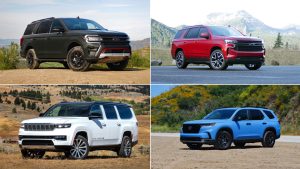Introduction:
In recent years, the automotive industry has seen an increase in the production and popularity of big cars. These vehicles, also known as sports utility vehicles (SUVs), have become a symbol of power, luxury, and status. However, their impact on the environment is a cause for concern. In this article, we will explore the environmental impact of big vehicles and the role that technology plays in mitigating their negative effects.
The Rise of Big Cars

Big cars have become increasingly popular in recent years. According to a report by the International Energy Agency (IEA), SUVs accounted for 42% of the global increase in carbon dioxide (CO2) emissions from passenger cars between 2010 and 2018. This rise in popularity can be attributed to many factors, such as:
– Lower fuel prices: As fuel prices have decreased, consumers have been able to afford bigger and less fuel-efficient cars.
– Safety concerns: Many consumers believe that bigger cars are safer due to their size and weight.
– Lifestyle choices: Big vehicles have become a status symbol, representing power, luxury, and success.
The Environmental Impact of Big Cars
The rise of big cars has come at a cost to the environment. These vehicles emit more CO2 than smaller and more fuel-efficient cars. According to the IEA report, SUVs emit 25% more CO2 than the average passenger car. This increase in emissions has contributed to global warming and climate change.

In addition to their impact on climate change, big vehicles also have other negative environmental effects. They consume more resources in their production, including raw materials and energy. They also take up more space on the roads and in parking lots, contributing to urban sprawl and the loss of green spaces.
Technology and Mitigating the Negative Effects of Big Cars
Technology has played an important role in mitigating the negative effects of big cars on the environment. One example is the development of electric SUVs. These vehicles use electric motors instead of internal combustion engines, resulting in zero emissions. Tesla’s Model X is one example of an electric SUV that has gained popularity among consumers.
Another example is the use of lightweight materials in the production of big vehicles. Lightweight materials such as carbon fiber and aluminum can reduce the weight of the vehicle, resulting in lower fuel consumption and emissions. The BMW X5 is one example of a big car that uses lightweight materials in its production.

In addition to these technological advancements, there are also policy measures that can be implemented to encourage the use of less polluting vehicles. One such measure is the implementation of emissions standards. Governments can set standards for the maximum amount of emissions that a vehicle can produce, encouraging manufacturers to produce more fuel-efficient cars.
Conclusion
The rise of big cars has had a significant impact on the environment. These vehicles emit more CO2 than smaller and more fuel-efficient cars, contributing to global warming and climate change. However, technology has played an important role in mitigating their negative effects. The development of electric SUVs and the use of lightweight materials in their production are just some examples of how technology can help reduce the environmental impact of big cars. Governments can also implement policy measures such as emissions standards to encourage the use of less polluting vehicles. As consumers, we can also play a role by choosing more fuel-efficient cars and reducing our reliance on big vehicles. By working together, we can help reduce the environmental impact of big vehicles and create a more sustainable future.




